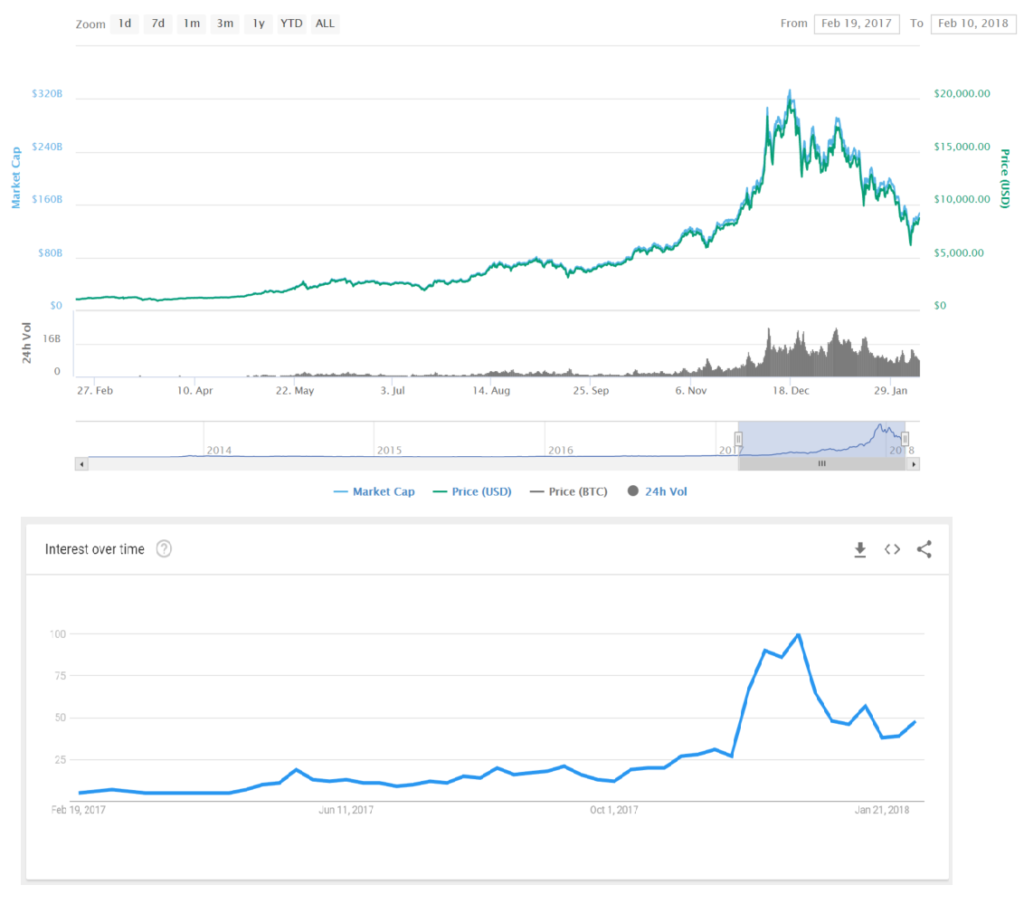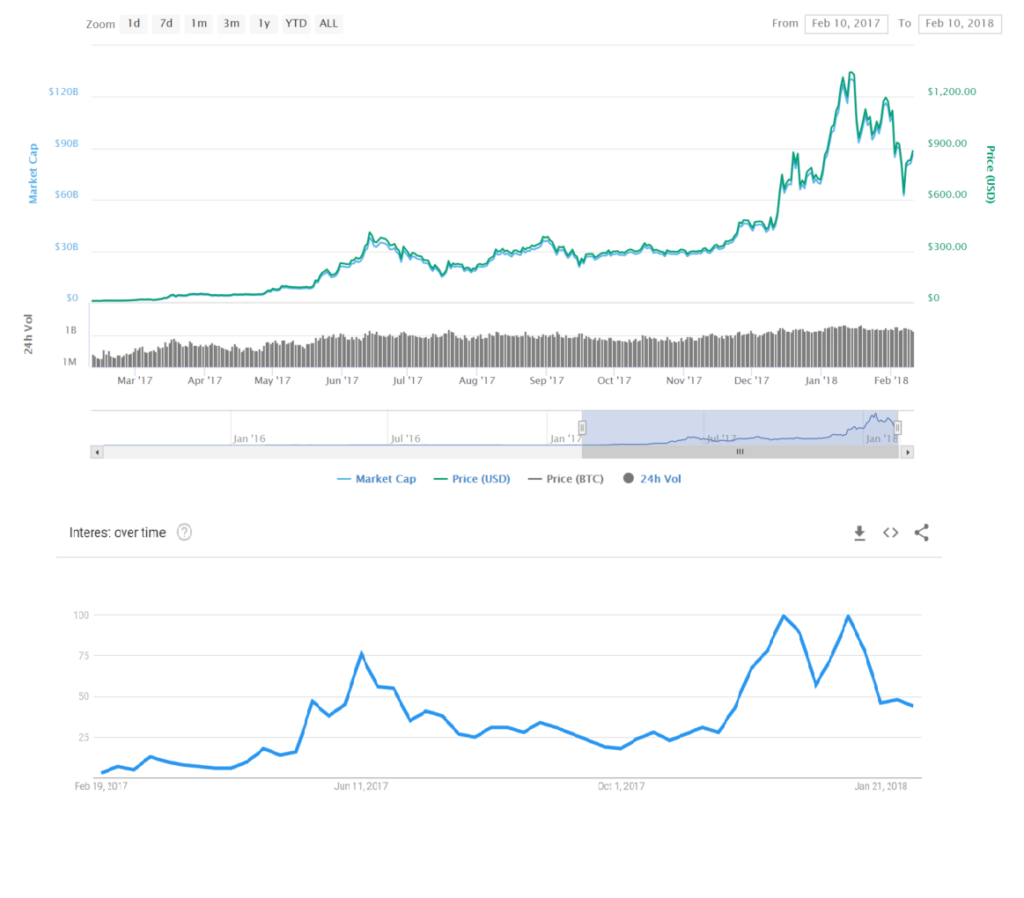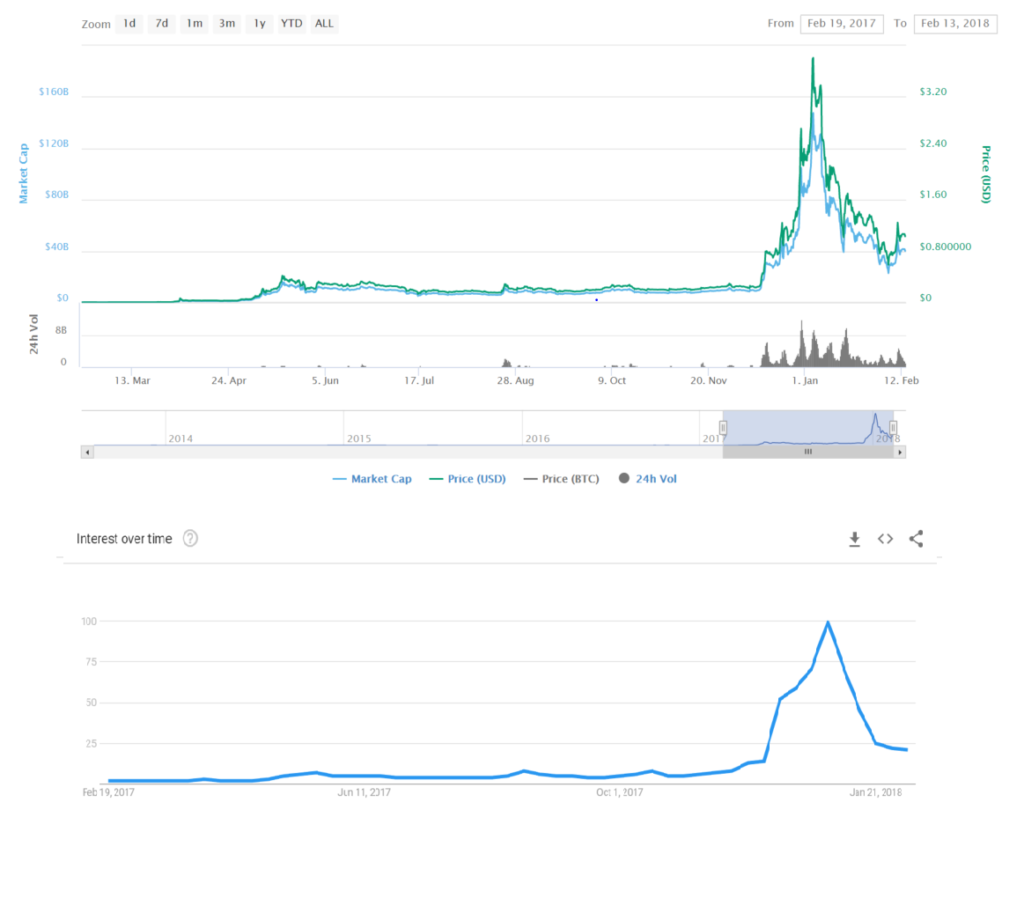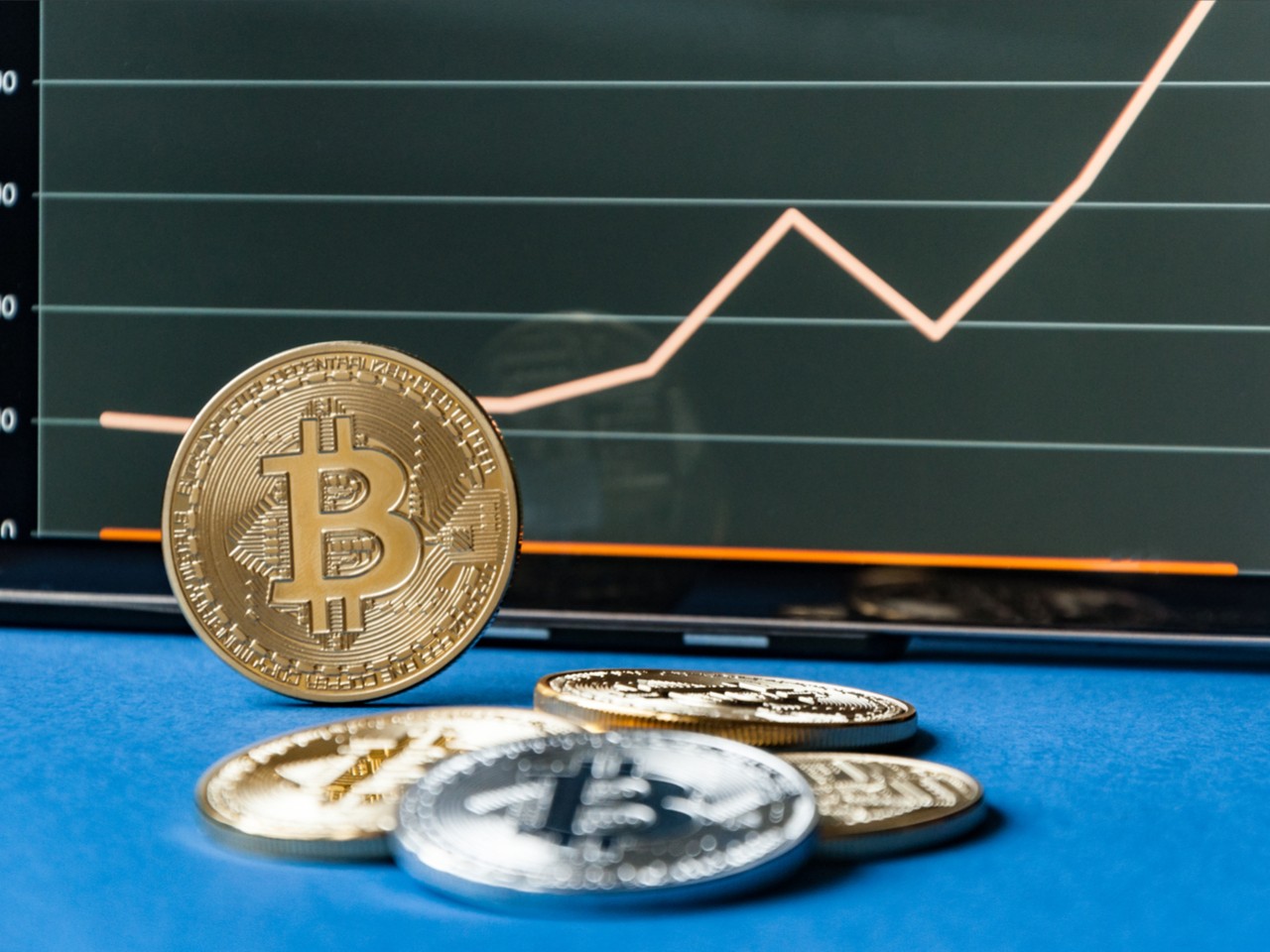To put it simply, yes. Yes, indeed they do.
Comparing charts over the last year, spikes in price and interest correlate for bitcoin, ethereum, and ripple. The pattern is clear with other major coins, too.
[caption id="attachment_4524" align="aligncenter" width="513"] Bitcoin price vs. Google search, comparison February 19th, 2017 - February 10th, 2018 (Top chart, CoinMarketCap; Bottom chart, Google Trends)[/caption]
Bitcoin price vs. Google search, comparison February 19th, 2017 - February 10th, 2018 (Top chart, CoinMarketCap; Bottom chart, Google Trends)[/caption]
But this was not such a clear conclusion just a few months ago.
In May 2017, a team of Turkish researchers from Adnan Menderes University looked for these sort of correlations on the American and Turkish versions of Google.
"Our findings imply that when USA Google 'bitcoin' searches increase, bitcoin prices drops. However, when Turkey Google 'bitcoin' searches drop or increase bitcoin prices don’t [sic] affected by these movements."
[caption id="attachment_4525" align="aligncenter" width="553"] Ethereum price vs. Google search, comparison February 19th, 2017 - February 10th, 2018 (Top chart, CoinMarketCap; Bottom chart, Google Trends)[/caption]
Ethereum price vs. Google search, comparison February 19th, 2017 - February 10th, 2018 (Top chart, CoinMarketCap; Bottom chart, Google Trends)[/caption]
Flaws in the team's published English translation aside, the researchers seemed to find crucial differences between markets. One issue with the study though might be that it looked at past search data and used it as an indicator of future trends. What December and January showed was simply a correlation.
A June 2015 study, out of the University of Cagliari in Italy, confirmed that relationship. "The cross-correlation result between Google Trends data and Bitcoin’s price also looks significant," they wrote, also noting similar correlations in Twitter chatter with BTC price movement.
[caption id="attachment_4526" align="aligncenter" width="494"] Ripple price vs. Google search, comparison February 19th, 2017 - February 10th, 2018 (Top chart, CoinMarketCap; Bottom chart, Google Trends)[/caption]
Ripple price vs. Google search, comparison February 19th, 2017 - February 10th, 2018 (Top chart, CoinMarketCap; Bottom chart, Google Trends)[/caption]
While the jury is still out on using recent search data to predict near-future price swings, we can make a reasonable assumption that rises and declines do run rather parallel. The question here is why recent numbers correspond to each other. The probable answer points to one of the biggest problems with cryptocurrency trading in general.
When gold was found in the village of Coloma, California, Americans and foreigners alike rushed to the area. Of course, if everyone is going to the same place, it is unlikely that everyone will strike it rich. The only people who would surely make out well would be the ship operators, road builders, and shovel salesmen.
In order to try to beat the competition, some people bet on nearby (but not too nearby) sites to find their treasure. The hope was that if they could find something where no one else was looking, they could cash in on an undiscovered vein of gold. This drove more people to move to California and populate the area quickly, but not everyone made it out wealthy.
With crypto, there is somehow a similar situation. Just as many prospectors saw opportunity in every hill and river, crypto buyers do not distinguish between various cryptocurrencies. This was evident by the recent December boom and the "great January correction" of 2018. All currencies moved in lock step. Forecasts on one currency would have been relevant to another.
"Contrary to what one would expect in a rational market, new currencies don't seem to reduce the value of old currencies," Goldman Sachs global investment point man Steve Strongin said last week. "They all seem to move as a single asset class."
Buyers and sellers treated all coins – be they independent, private tokens, or pegged to fiat – in exactly the same manner. That vision of fast returns had seismic effects generating tidal waves of new investors. Everyone wants a piece of the action, so when a lot of people hop on board, they immediately drive up demand. Their demand drives prices up, only for the market to correct itself drastically, once excitement dulls.
However, new buyers do not appreciate what differentiates bitcoin from ethereum, or new ICOs from one another. For them, they are different horses in a race, cheap to buy now before they soar in value later.
As headlines picked up initial increases in coin prices in early December, people took note. What followed was an explosion in purchases from new investors, including many with credit cards.
The flurry of buys turned into a blizzard. Several US and European banks banned credit purchases of crypto to discourage debt investments. Governments all over the world drafted new regulations. Some ministers, in South Korea and India particularly, beat their chests threatening outright bans.
As new buyers were held up by bank rules or overwhelmed exchange approvals, the price collapsed.
As coins act rather stable – BTC has hovered in the $8,000-$9,000 range for the past week – we should take stock in how easily governments got a grip on an unregulated market.
The mere threat of action by Western States was enough to drive prices down. In conjunction with banks' own efforts, the prospect of a surefire investment well dried up. That sent general interest plunging.
Capitals around the world seem to know that we can predict the movement of crypto prices based on general interest. It's as easy as looking at search trends. Media fervor drove prices up, then bad news scared off would-be first-time buyers.
While this illustrates a problem for cryptocurrency, it is to be expected. As awareness grows, more people will assign value to what is being traded. Over time, perhaps after a bubble burst, the market might consolidate to a few currencies. Diminishing the search-price correlation probably will take years.
Until then, expect general interest to reflect in Google's search traffic where novices seek out information and exchanges.
Comparing charts over the last year, spikes in price and interest correlate for bitcoin, ethereum, and ripple. The pattern is clear with other major coins, too.
[caption id="attachment_4524" align="aligncenter" width="513"]
 Bitcoin price vs. Google search, comparison February 19th, 2017 - February 10th, 2018 (Top chart, CoinMarketCap; Bottom chart, Google Trends)[/caption]
Bitcoin price vs. Google search, comparison February 19th, 2017 - February 10th, 2018 (Top chart, CoinMarketCap; Bottom chart, Google Trends)[/caption]But this was not such a clear conclusion just a few months ago.
In May 2017, a team of Turkish researchers from Adnan Menderes University looked for these sort of correlations on the American and Turkish versions of Google.
"Our findings imply that when USA Google 'bitcoin' searches increase, bitcoin prices drops. However, when Turkey Google 'bitcoin' searches drop or increase bitcoin prices don’t [sic] affected by these movements."
[caption id="attachment_4525" align="aligncenter" width="553"]
 Ethereum price vs. Google search, comparison February 19th, 2017 - February 10th, 2018 (Top chart, CoinMarketCap; Bottom chart, Google Trends)[/caption]
Ethereum price vs. Google search, comparison February 19th, 2017 - February 10th, 2018 (Top chart, CoinMarketCap; Bottom chart, Google Trends)[/caption]Flaws in the team's published English translation aside, the researchers seemed to find crucial differences between markets. One issue with the study though might be that it looked at past search data and used it as an indicator of future trends. What December and January showed was simply a correlation.
A June 2015 study, out of the University of Cagliari in Italy, confirmed that relationship. "The cross-correlation result between Google Trends data and Bitcoin’s price also looks significant," they wrote, also noting similar correlations in Twitter chatter with BTC price movement.
[caption id="attachment_4526" align="aligncenter" width="494"]
 Ripple price vs. Google search, comparison February 19th, 2017 - February 10th, 2018 (Top chart, CoinMarketCap; Bottom chart, Google Trends)[/caption]
Ripple price vs. Google search, comparison February 19th, 2017 - February 10th, 2018 (Top chart, CoinMarketCap; Bottom chart, Google Trends)[/caption]While the jury is still out on using recent search data to predict near-future price swings, we can make a reasonable assumption that rises and declines do run rather parallel. The question here is why recent numbers correspond to each other. The probable answer points to one of the biggest problems with cryptocurrency trading in general.
When gold was found in the village of Coloma, California, Americans and foreigners alike rushed to the area. Of course, if everyone is going to the same place, it is unlikely that everyone will strike it rich. The only people who would surely make out well would be the ship operators, road builders, and shovel salesmen.
In order to try to beat the competition, some people bet on nearby (but not too nearby) sites to find their treasure. The hope was that if they could find something where no one else was looking, they could cash in on an undiscovered vein of gold. This drove more people to move to California and populate the area quickly, but not everyone made it out wealthy.
With crypto, there is somehow a similar situation. Just as many prospectors saw opportunity in every hill and river, crypto buyers do not distinguish between various cryptocurrencies. This was evident by the recent December boom and the "great January correction" of 2018. All currencies moved in lock step. Forecasts on one currency would have been relevant to another.
"Contrary to what one would expect in a rational market, new currencies don't seem to reduce the value of old currencies," Goldman Sachs global investment point man Steve Strongin said last week. "They all seem to move as a single asset class."
Buyers and sellers treated all coins – be they independent, private tokens, or pegged to fiat – in exactly the same manner. That vision of fast returns had seismic effects generating tidal waves of new investors. Everyone wants a piece of the action, so when a lot of people hop on board, they immediately drive up demand. Their demand drives prices up, only for the market to correct itself drastically, once excitement dulls.
However, new buyers do not appreciate what differentiates bitcoin from ethereum, or new ICOs from one another. For them, they are different horses in a race, cheap to buy now before they soar in value later.
As headlines picked up initial increases in coin prices in early December, people took note. What followed was an explosion in purchases from new investors, including many with credit cards.
The flurry of buys turned into a blizzard. Several US and European banks banned credit purchases of crypto to discourage debt investments. Governments all over the world drafted new regulations. Some ministers, in South Korea and India particularly, beat their chests threatening outright bans.
As new buyers were held up by bank rules or overwhelmed exchange approvals, the price collapsed.
Governments seize the means of production
As coins act rather stable – BTC has hovered in the $8,000-$9,000 range for the past week – we should take stock in how easily governments got a grip on an unregulated market.
The mere threat of action by Western States was enough to drive prices down. In conjunction with banks' own efforts, the prospect of a surefire investment well dried up. That sent general interest plunging.
Capitals around the world seem to know that we can predict the movement of crypto prices based on general interest. It's as easy as looking at search trends. Media fervor drove prices up, then bad news scared off would-be first-time buyers.
While this illustrates a problem for cryptocurrency, it is to be expected. As awareness grows, more people will assign value to what is being traded. Over time, perhaps after a bubble burst, the market might consolidate to a few currencies. Diminishing the search-price correlation probably will take years.
Until then, expect general interest to reflect in Google's search traffic where novices seek out information and exchanges.

